#the gerudo tradition
Note
If Ganondorf was lying to anyone during that Wind Waker speech, he’d be lying to himself. The gerudo desert was indeed harsh, and Hyrule sucked during his time, but legit everything he did in Ocarina of Time is completely unjustifiable, except for the murder of the King of Hyrule. The man sat in luxury for 7 years with monsters surrounding the land, while his people remained in the desert. Yet at the end of the day, he believed that he had every right to do all of that.
Self-justification isn’t a trait that’s outright noticeable with Ganondorf, but Wind Waker puts it out in the open and shows that yes, the self proclaimed “King of Evil” truly believes he’s deserving of the world, and that his circumstances justify his crimes.
I feel like the fandom misses that while Ganondorf may not be this complex 5d villain, he still carries an interesting amount of traits like this
Hey, thanks for the ask!! I'm sorry, I haven't slept in over 24h and felt particularly rhapsodic today so uhhhh sorrryyyyy for being cringe about my little guyyyyyy (and the approximate use of English language that might ensue)
So yeah, I think there's absolutely a huge part of that, trying to make sense of the violently absurd situation he found himself in, a monster and one of the last people who remembers Hyrule and how it was destroyed, and rationalizing to himself why it is not meaningless.
I have to say, not to be uhhh a parody of myself, but I think it could be a little bit more complicated than that (all of it being interpretations of the text that I don't think canon entirely backs always, but my point is that it could be read out of it).
If Ganondorf wanted any meaningful chance to reshape his own reality, then there's no doing that without access to the Triforce. If he had wanted to go for the King's head and nothing else, he would have been stopped immediately by everybody who do have access to shards of the keys to the Sacred Realm (not to mention how trigger happy Zelda was about wishing ????? something to the Triforce about erasing him in some form). I don't think it would have been reasonable to aim for anything but the Triforce as a military goal --not to mention that his beef is half with Hyrule, and half with the Goddesses themselves for considering the gerudos beneath them in some form and for some reason (which becomes even more apparent and deranged in Wind Waker, as part of why he can't let go of Hyrule in my opinion is because their intervention was so violent he simply cannot wrap his head around it and, as usual, Will Not Be Defeated >:((( because he's that kind of bitter little shithead, which I uhhhh relate to a little too much maybe). And then, well. You can't exactly ask for the Triforce and be nice about it, right?
I'm not saying he wasn't gleefully horrible about it the entire time, but I can absolutely see a case of him being self-centered enough to see each of his actions as the necessary (or righteous/vengeful) next step to get closer to his goals, and one thing leads to the other, and after seven years of strife, well, the kingdom you wanted to rule is a pile of rubble, ash and misery you enforced at every step, and oops! You have alienated absolutely everyone who aren't your weird moms!
There's a ton of things to say about the many interpretations that could be made of his relationship to the gerudos so I won't over-expand on that, but, uhhhh yeah he probably used them, or at the very least ruled them with an iron fist to enforce his own power he believed unquestionnable (even if the goal was genuinely to do things for their sake, which in my opinion could still be argued --Hyrule is a big nightmare place during his reign, but the Valley is the only location basically untouched with arguably Kakariko after all).
To be honest, I think TP Ganondorf is more accursed with a sense of self-justification than WW Ganon, who has a surprising amount of clarity on his own motives (to restate my tags on a post I just reblogged: I don't think "I coveted this wind, I suppose" is particularly self-pitying, it's soberingly self-aware if anything). TP Ganon is the one who's obsessed with divine purpose and considering himself a weird take on the Chosen One.
But yeah, I think... To be completely honest, I sometimes feel like Ganondorf's potential (!!! not actual execution, very important to draw this distinction) is just kind of too large for the IP that birthed him? The full breadth of his complexity cannot be explored in a setting that demands he merely generates a simple conflict that doesn't seriously question the status quo while everything about him inherently begs for it (and I love Zelda and its simplicity and what it does, to be very clear!). Like, I know this is just me justifying my own investment to a degree, but... his relationship to the gerudo culture, his relationship to gender, to divinity, to fate, to self-definition, to absolute resistance grinded down to the point of absurdity (but at the same time, what else is there to do)... like all of this absolutely has potential to be large and epic and breathtaking, but. Nintendo needs to preserve the statut quo. And Ganondorf just cannot express all of these themes without having this simple world literally collapse around him.
This is what I find incredibly compelling about this dramatic disaster of a guy. And the very media that suggested all of these contradictions and inner conflicts (without necessarily understanding them at first I think) is now fighting tooth and nail against what it introduced, what he can embody and once questioned (in WW most potently) for the sake of Hyrule's moral balance, backpedalling into a state of simplicity that just never truly existed to that degree before --partially, in my opinion, because this conflict is scary to face heads on without taking significant artistic risks I am not confident we will ever see again, to be uhh less than optimistic.
So yeah! He isn't that complicated as the villain of the children video games for sure!! But. As a character, there's so much there, just sitting right under the surface.
#asks#ganondorf#wind waker#ww#oot#ocarina of time#gerudos#thanks for the ask!! I'm genuinely sorry for my lyrical whatever#he doesn't deserve any of this he's a shithead#but#I've been having a six months long existential crisis about everything awful and everything incredible about this character#(it's been dormant for years but it did hit like a truck all at once)#so I kind of splattered my thoughts everywhere sorryyyy#and I didn't even mention the hyrulean civil war#the sheikahs#the gerudo tradition#the influence of koume and kotake#etc etc etc#bitches be like “no I don't defend ganondorf's actions!!” and then write poetics about tragedy and ambiguity and legitimacy#and talk shit about the goddesses#anyway that's me I'm bitches welcome to my blog#(descant and everything I write is exactly about what I just expressed above)#(but less sleep deprived and more Story)#((I'm publishing the next chapter soon btw I just need to adjust it but it's a difficult one))
56 notes
·
View notes
Photo


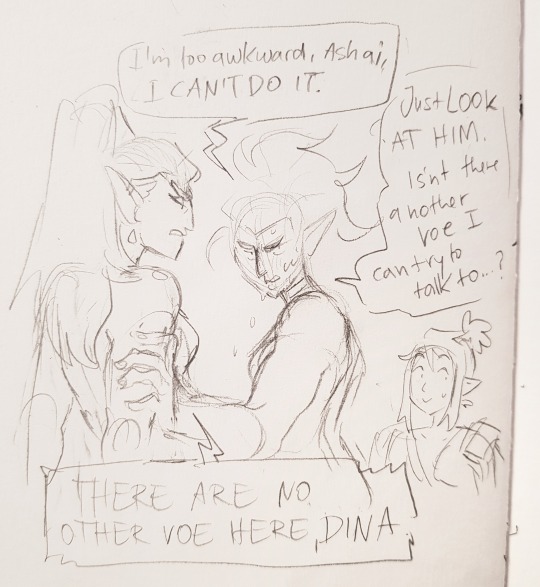
Link is setting an unrealistic standard for voe at the “voe and you” classroom. ✨
34K notes
·
View notes
Text

This was everything I was looking for in totk
2K notes
·
View notes
Text

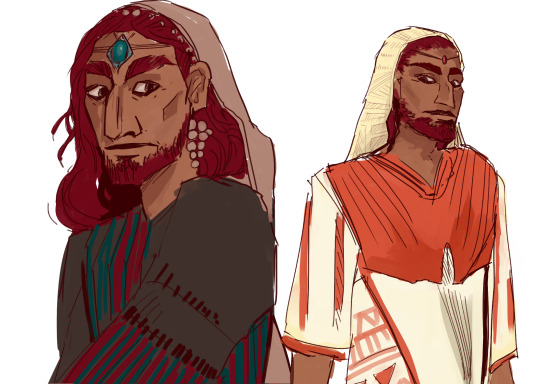
two things that bother me about all zelda gerudo designs so much is that the female designs are just completely oversexualized for no reason (would be so fucking impractical in a desert) and that ganondorf's outfit is based on eastern asian fashion and not... middle eastern fashion?
#myposts#totk#zelda#myart#the legend of zelda#i love the gerudo so much but someone really needs to take them away from nintendo :(#like these cheap halloween faux belly dancer outfits... dude.#i mostly used palestinian traditional outfits for these designs because their fashion is really cool :) one of them is from a yemeni one th#and i also gave ganondorf more traditionally female outfits because....... like i said.#why would a culture that isnt aware of gender 99% of the time have a different type of fashion per gender.#like that would be so dumb of them :/
83 notes
·
View notes
Text

riju with her hair down because why not!!
#nocturnaldoodles#drawing#sketch#traditional drawing#makeela riju#riju#legend of zelda#the legend of zelda#fanart#loz fanart#loz#tloz#totk riju#sage of lightning#lady riju#chief riju#sage riju#gerudo sage#gerudo#riju totk#totk art#zelda totk#totk#tloz totk#loz totk#tears of the kingdom#zelda tears of the kingdom
56 notes
·
View notes
Text
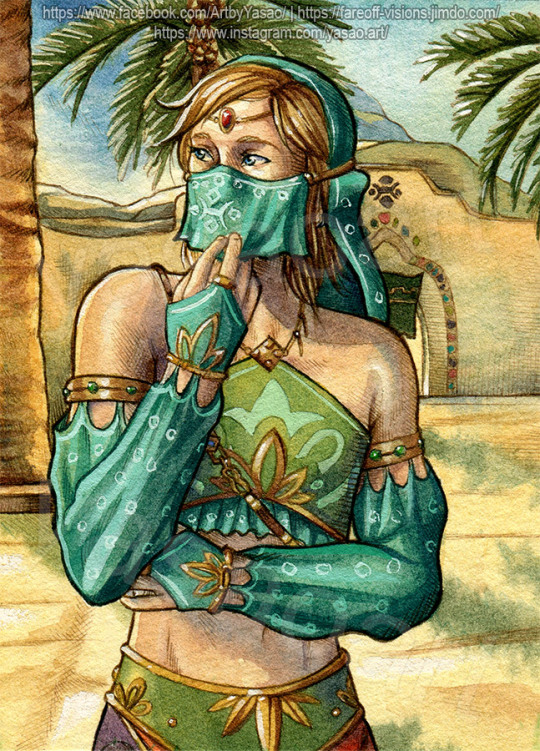
Oops, I went silent again - I blame it on Tears of the Kingdom, tho. XD Ever since the game released I've been spending FAR too many hours in Hyrule each day. I'm honestly having a lot of fun - HOWEVER! I do miss some things: this armor, for example. There's just something weird about walking around Gerudo Town in Link's usual attire, especially when no one bats an eye.
I painted this pretty vai in April 2021, but I still adore the artwork a lot >U< (And I have more Zelda fanarts in the making. ♥)
Keep reading to find a close-up photo of the watercolor painting. :3

#link breath of the wild#gerudo town#the legend of zelda#breath of the wild#tears of the kingdom#vai link#vai#gerudo vai#gerudo link#tloz fanart#tloz botw#breath of the wild fanart#link fanart#botw fanart#watercolor painting#traditional fanart#yasaoart
73 notes
·
View notes
Text
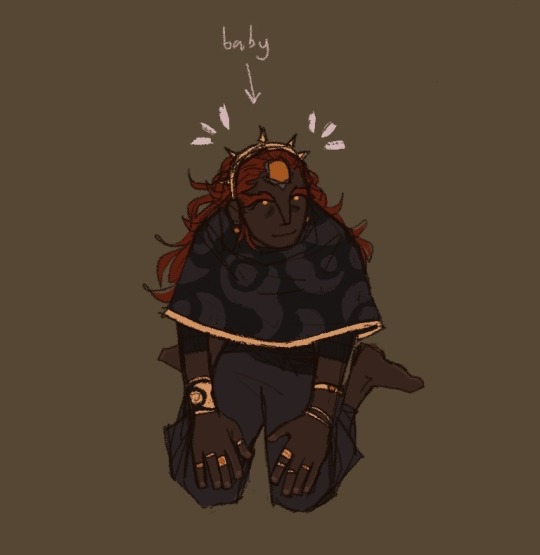
little gan doodle,,, i think he was very lanky growing up. like a baby deer or something
#tloz#ganondorf#i also like how gerudo leaders seem to always wear black…..like ganondorf and urbosa and riju all wear black as their most prominent color#like its one of a few traditions that seems to have survived from ganondorf’s time well into the botw era#as well as the crown ganondorf wears in TP! which bears a lot of resemblance to the back of the thunder helm#idk it’s cool to think about lol
241 notes
·
View notes
Text
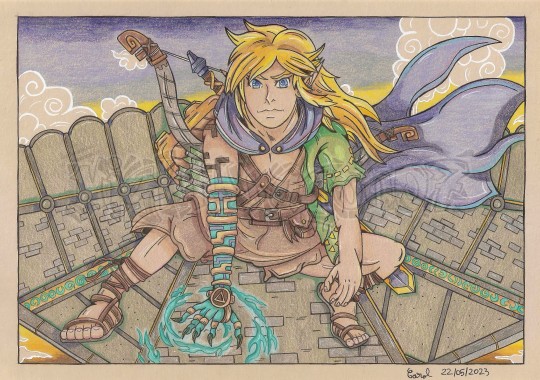

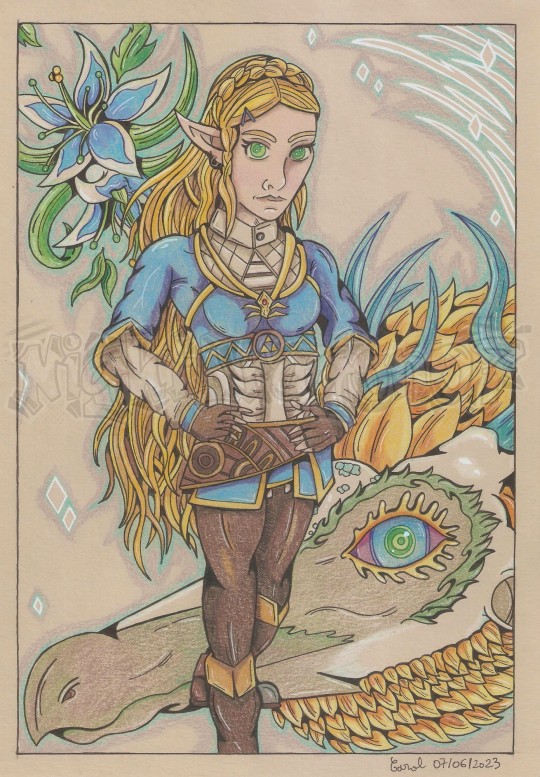
Triforce trilogy
Of Power, Courage and Wisdom
Fanart of The Legend of Zelda: Tears of the Kingdom.
Color pencil drawing on brown paper
22/05/2023
Art (C) Carol (NightDragon07)
The Legend of Zelda (C) Shigeru Miyamoto & Takashi Tezuka
#traditional art#color pencil#drawing#fanart#fanart traditional#fantasy#the legend of zelda#tears of the kingdom#link#loz link#zelda#princess zelda#ganondorf#hylian#gerudo#dragon#eastern dragon#white dragon#light dragon#flower#desert#sky#myart#mystyle#nightdragon07
35 notes
·
View notes
Note

Tessa.
Nala wants to give Florence this outfit. You can change the colors to match Florence's colors if you want to. :3
Nala: Florence! You HAVE to wear this and you HAVE to keep it! >:3
Florence: ...
....
Steep: BAHHAHAHA!!! *he laughs hysterically off on the side*

Florence: ... Thanks, Nala. I hate this "gift" so very much...
Oh my, it doesn't seem like Florence likes the Gerudo outfit very much XD
#wreck it ralph#ask#send asks#roleplay#art#traditional sketch#sketched#sketches#sketch#florence von schweetz#flo#florence#alternate universe#next gen au#next gen#sugar rush next gen#next gen oc#next generation#steep#gerudo#gerudo outfit#legend of zelda#nala
25 notes
·
View notes
Text
In an OOT mood lately so I drew some of the Gerudo characters!

they turned out pretty cool 😎
#art#my art#artists on tumblr#art by me#fanart#traditional art#pencil sketch#gerudo#zelda fanart#ganondorf#twinrova#nabooru#gerudo guards#ocarina of time#loz fanart#loz#legend of zelda#oot#oot fanart#oot ganon#gerudo fanart#ganon#koume#kotake
126 notes
·
View notes
Text
A model sheet for Link ....
What can i say , i just had to do it 😔

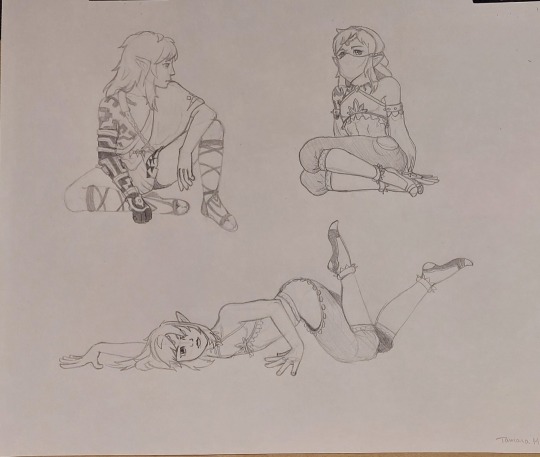
#artists on tumblr#drawing#sketch#my art#art#sketchbook#pencil#traditional art#link#legend of zelda#tears of the kingdom#gerudo outfit#slutty link#posing#model sheet#he is baby girl
9 notes
·
View notes
Text

behold: my second least favorite string of words in the entirety of Tears of the Kingdom.
(it's a little less transparent why this time so I'll explain my thoughts under the cut)
So why do I not like this?
In so many words: because if you remove it, the scene still works, but you lose the moral certainty of what is going on.
This single sentence does so much legwork for the entire game (the kind I dislike), to the point where I'm about 60% sure it's the product of a rework that realized how ambiguous Rauru's position was as the Good Rightful King and needed to nervously reassure the players that Ganondorf Is and Always Was the Invader, Actually.
(no matter that it leaves the gerudos in this awkward in-between state of both invaders and victims, while never dwelling in the specifics of their history and their own agency in the entire thing; brushed off as a sin they have to expiate through loyalty to the winners of that particular strife, but without explicitely blaming them either to avoid the implications of what that would have looked like)
If you remove it, not only do you lose a pretty clunky line that detracts from Ganondorf's intimidating presence (who is he even speaking to? who needs to hear this right now?) that honestly speaks for itself when it comes to his experience with warfare, but also you lose any tension and any mystery regarding why he is attacking in the first place.
You also... kind of rob Ganondorf's motivations of their meaning. "Hyrule will bow down before me" leads to asking... why? What does he want? What does he see in those lands? And what little we get with Rauru and then Link during the final fight begs more questions; why do you prefer hardship to peace? Why do you value strength? What leads you to want to rule a land devoid of survivors, become a king without a kingdom? I don't think we ever get satisfactory answers. If you remove this sentence, on the other hand... Subtextually, it becomes pretty clear that his motivations is that he felt threatened by Rauru's power, which is ripe with subtext and questions about whether this is a legitimate reaction, whether his "no survivor" stance is due to a feeling of betrayal when his own people turned against him post the Demon King shenanigans... I'm not saying it would fix the entire game's writing, far from it, but it would already do *so much more*.
(genuinely, I think he could have stayed completely silent during the Molduga Assault, speaking only in the Show of Fealty before going completely nuts after Sonia's murder, and it would have worked MUCH better in terms of characterization but anyway anyway
EDIT: ALSO!!! that way he wouldn't speak hylian to fellow gerudos, which is weird inherently)
Without this line, the core of the tension between the gerudos and Hyrule comes front in his conversation with Rauru; it allows the cause of his hostility to be Rauru's invitations, that he would have taken as a threat, and would have still made him warlike and domineering without making him cartoonishly flat, because, once again, Rauru is not acting in a particularly more legitimate way when Zelda arrives in Ancient Hyrule; and it would have been... fair to point that out. And make for better characterization for Rauru, and Sonia, and Mineru, and everybody. But the priority was for Hyrule to be pictured as unquestionably holy; always legitimate, always truthful, always beautiful, always just.
Also, and this is more of a nitpick but: why would Ganondorf want Hyrule, specifically, to bow down before him also? Was he at war with the rest of the disparate tribes before, and just carried on his ambitions to the very very newly-founded kingdom as they allied under a new banner? (though it seems to be implies the lands were crawling under monsters in a generic sense, and not Ganondorf's attacks in particular) Why would he even consider Hyrule a legitimate entity worth taking over then, if it is so new, born from the will of a powerful rival, founded by what is basically a stranger to these lands? Why would he covet something so young instead of destroying it and just calling the lands Gerudo Lands II or Grooseland or something?
I don't think any of that was even accounted for, because, beyond everything else: to me, this sentence is so clearly and painfully crammed in here to shield Hyrule from any potential blame and immediately characterize Ganondorf as Bad without having to remove any of the causes that could lead one to side-eye Rauru's little pet project as equally questionable.
Beyond the clumsiness, it is cowardly --and, I think, a little damning.
#totk#totk critical#when will my brain return from the imprisoning war...#ganondorf#gerudos#rauru#tl:dr it is cowardly and reveals that nintendo knew about the Implications to some degree#sometimes less is more#really in that case less would have been so much more#it is literally ganondorf's first chronological line#yeah sure it tells you everything about the guy but#it's also such a bold commitment to flatness and self-righteousness that... yeah#and before I hear any “at least Rauru wasn't using force” I mean as far as we know though?#the constructs attack anyone deemed an “invader” on sight one of the things rauru does is to apologize for this#(I reread Rauru's initial dialogue in the Sky Islands and it would have been SO GOOD if any ambiguity would have been allowed)#(like the thing about Constructs mindlessly pursuing their useless tasks forever disquieting him...)#(yeah buddy so true that could uhhh almost be a metaphor for something else regarding purpose and lineage or something wow)#and even if he didn't use force directly the power dynamics and repeated invitations are still undeniably questionnable#like my guy why do you want everybody to kneel down to you what's up with that do we unpack this or#at least ganondorf was like.... born and raised a king (not that it excuses anything but he inherited pre-existing traditions)#so did zelda#she was born in an imperfect system and did whatever she could about it#rauru *crowned himself*#he *made* the system
140 notes
·
View notes
Text
"Hyrule will bow before me."
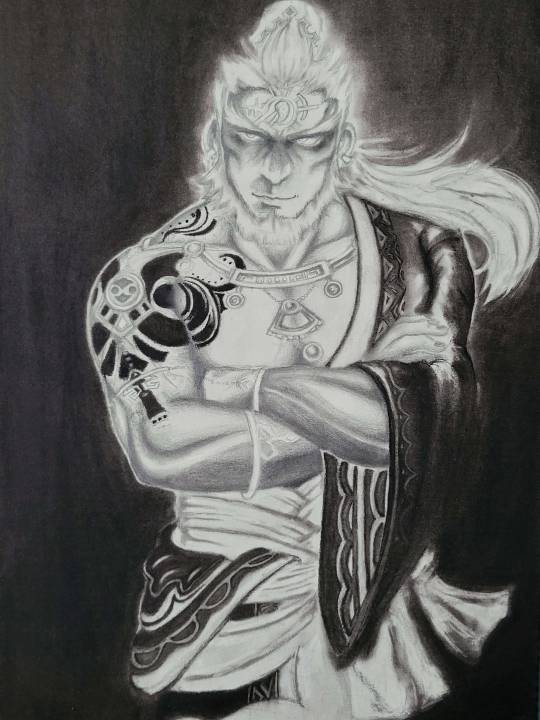


[5/27/23] AH! I'm so exited to finally be able to post on here! (even though my camera quality isnt the best :'D had to draw ganon for completely normal reasons.... (I'm normal about him I swear....)
#no because i cant even describe the guttural noises that came from my mouth when i saw him in the gerudo assault cutscene#it was like 2 in the goddamn morning too#literally had to leap across my bedroom to grab my headphones from my desk#anyways... please give me just one chance king i swear ill do anything ALSO MATT MERCER I LOVE YOUU OMFG HE DID SUCH A GOOD JOB VA'ING HIMM#ganondorf#ganon#loz#loz totk#sigh#rehydrated ganondorf#tears of the kingdom#botw#charcoal#graphite pencil drawing#traditional art#yippee for first post!!!#MyArts[+_=]-b
22 notes
·
View notes
Text
LoZ - Gerudo Wedding Traditions
It used to be that the Gerudo, traditionally speaking, would propose to their significant others (in the case of more Gerudo, men & in the case of the Centennial Kings, women) by giving them pieces of jewelry that they made themselves.
Also, traditionally speaking, they would do so while saying "Kàvt shïchïso yūg nï’jï." Which means, "Bind your soul with mine."
Though, a few thousand years ago, gifting your husband with more handcrafted jewelry, even after marriage, began to take on the message of "I would marry you again if given the chance."
However, due to most Hylian men not being particularly into jewelry, the Gerudo began to also start gifting things like handmade trinkets, clothes, & other items all became various forms of ways to showcase a reaffirmation of love while handmade jewelry retained its expanded meaning of proposal or "I would remarry you."
Unfortunately, being the one to propose went out of fashion among the Gerudo over time as they began to make attempts at appearing meeker in an effort to mimic Hylian women & thus, hopefully, increase chances of catching a Voe's attention.
Now, the act of proposing with handmade jewelry & traditional Gerudàn is more so something that a Gerudo Voe does for the sake of tradition or something a Hylian, Sheikah, or Ovelian (human with rounded ears) does in an attempt to showcase that he legitimately cares about her & is willing to learn more about not just her, but also her culture. (Which actually makes it quite a sweet gesture.)
---
Weddings are considered big deals for the Gerudo, which is why they are referred to as Màtu'kàvtéda Agàznien or "love-binding festivals." As whenever a wedding takes place for the Gerudo, a small festival is held.
Gerudo in general are just very exclusive with their hearts. So, for one to find someone that they want to bind themselves to for the rest of their life, that's a big deal.
—
Brides wear what is known as a Màtu'kàvtéda Shàree with a Mátu'kàvtéda Bàndaràshï, a Kopfab, & a Màtu'kàvtéda Hunfàm.
A Màtu'kàvtéda Shàree is a beautiful Gerudàn dress made of fine silk (a saree). Typically features vibrant colors, at least 3, & interesting patterns in gold or silver. Typically comes with a wide, gold or silver Àrïqna, or fabric belt, that cinches the waist closely & covers most of the belly. Considered very formal. Can be either one piece or two pieces. Two pieces is generally preferred by most Gerudo. However, one piece is considered most formal & generally what is worn by royal brides. - Inspired by Hindu saree.
A Màtu'kàvtéda Bàndaràshï is a strip of fabric that acts like a sash & is typically draped over one shoulder & circles around the opposite hip. Typically a different color to the Shàree to give variation. They often have gold or silver patterned borders. Non-wedding Bàndaràshï leave both arms free & unencumbered, unlike wedding Bàndaràshï, which are usually very long & hang over an arm to trail down to the floor. If worn by a bride who is either a queen or is marrying a king, the Bàndaràshï & Hunfàm must both match, with the Shàree & Kopfab being a different, yet complementary color.
A Kopfab is a colorful, hooded head veil (similar to a hooded cathedral or regal veil that doesn't need to be tied around the neck) with gold or silver embroidered patterns around the hem to be worn on the head of a queen, but specifically does not cover the face. It is opaque instead of sheer like a Hylian wedding veil would be. The longest that it can be is hip-length. It can also be worn by civilian Gerudo, but only on their wedding days. The queen is expected to wear it as formal attire. Typically paired with a Kafchita or Shàree or some other dress of Gerudàn make. Màlàki Kopfaben, however, are meant for royal weddings & reach down to the floor, many even trailing behind.
And a Màtu'kàvtéda Hunfàm is a type of face veil that Vai wear when they are getting married. Brides wear them for an entire week before the wedding so as to avoid bad luck as the bride must be kept clean of jealous intent from other Vaien or the lustful gazes of Voen other than the bride's intended. If anyone sees her face clearly before then, it is said to bring about disaster for the marriage. It is then worn to the wedding, where, upon finishing the ceremony & sacred rites, the groom removes the Hunfàm to be the first to look upon the face of his new wife before sealing the contract with a kiss. It's just superstition, but it's tradition at this point. This specific Hunfàm is held in place by a pair of hooks that wrap around the ears much like glasses. This makes it easy for the groom to remove.
Royal brides generally have their hair threaded with silver & have bold liner resembling that of the Egyptians, just silver.
They also wear a pendant bearing her family's crest.
—
The groom wears a Shiwàni (or sherwani IRL). A finely made formal top made of silk. Usually sleek, thin, & tailor-fitted with an imperial collar & gold-threaded embroidery lining the cuffs, the collar, & the split where it's buttoned. Is typically buttoned up the middle or buttoned asymmetrically. Sort of a tunic as it generally reaches the knees at most. It typically bears his family crest across the back. Over this would be a Bàndaràshï worn diagonally much like the bride's.
He will likewise wear a golden pendant also bearing his family crest.
Under that would be a pair of Sirwàl or loose-fitting pants.
Of course, all finely made & made with vibrant colors & designs.
Kings will also typically wear their Túijïl or halo crown (think TP & HW Ganondorf) with their hair threaded with gold & their eyes lined with gold eyeliner, much like the Egyptian Pharaohs of old but gold.
The king will also wear a cape of fur, a pair of fine Gàzmen (the shoes from the Gerudo Vai Set) or golden greeves (like from the Desert Voe Set), & hand chains like what we see TotK Ganondorf wear or a pair of golden guantlets like HW.
And, if not a Shiwàni, then he'll either wear a Juddàb (a plain shirt with an imperial collar) with a Dosāya (think a Zhuba) over it or wear just a Dosāya or go barechested & wear a variety of different jewelry. In such a case as going barechested, he'll also wear a Shendyazàr (a kilt-like loincloth much like the Egyptians wore) over his Sirwàl.
—
Gerudo weddings are traditionally held either in the town square or at a Shrine to Vah Kàvtrïna, the Gerudo Goddess of Love, Passion, Marriage, & Vivifatility (word referring to both fertility & virility).
For more on Vah Kàvtrïna, go here.
Likewise, it is always presided over by a Kàvtrïna'eshônï or Priestess of Vah Kàvtrïna.
—
Gerudo weddings are set up differently. Instead of the bride walking down the middle of the pews with the groom waiting for her at the altar, the bride & groom instead enter from opposite sides of the altar with the audience facing towards the altar.
The bride & groom enter at the same time & meet each other at the altar in the center which symbolizes how marriages require a lot of compromise, thus meeting each other halfway.
---
After the vows, the pair are told to exchange family crest pendants, symbolizing that they have taken each other into their family before asking them to "seal their new bond before the eyes of Vah Kàvtrïna."
Due to the superstition surrounding the bride first being seen by anyone other than her groom, it is tradition for all to turn their gaze away the moment before the groom removes the veil.
Then they kiss to seal the contract.
After which, they both turn to the guests, hand-in-hand, throw up their arms & shout "Tïsarāya!" Meaning "Rejoice!"
Then, the guests turn their gazes back, cheer, & shower the couple with oasis flowers like confetti & the town begins the celebrations.
—
Such festivities tend to revolve around vibrant music, delicious food, & lively dancing. As well as extravagant gifts to the lucky pair.
Sense telling stories through dance is such a huge part of Gerudo culture. The bride & groom's first dance together is meant to act out some deeply important part of their courtship. Whether it be how they first met, how they fell in love, or how the engagement was finalized.
Desserts during the celebration generally feature Oasis Honey or Sàbaar Fruit (agave) & Amorous Figs. Which figs are heavily associated with Vah Kàvtrïna for their amorous effects & eating them during that time is said to bring good luck on one's wedding night as well as increase the likelihood of conception.
As such, the couple will traditionally be served Fashïna Amrïta near the end of the celebration, which is a type of Oasis Honey, fig, & palm flower mead.
---
Once the festivities are over, the couple are expected to bathe each other & brush each other's hair, which is thought to be a very intimate bonding experience to the Gerudo who take bathing very seriously.
This is believed to help them get used to each other's bodies before the act.
It isn't uncommon for newlyweds' first time together to actually be in the bath, in fact. But that's to be expected.
---
LoZ Cultural Masterlist
5 notes
·
View notes
Text

The REAL reason Link has longer hair in Tears of the Kingdom.
#loz link#botw link#totk link#totk#legend of zelda#loz totk#botw totk#gerudo#traditional drawing#traditional art#sketchbook#sketch#gerudo vai outfit#loz#loz fanart#loz tears of the kingdom
15 notes
·
View notes
Text
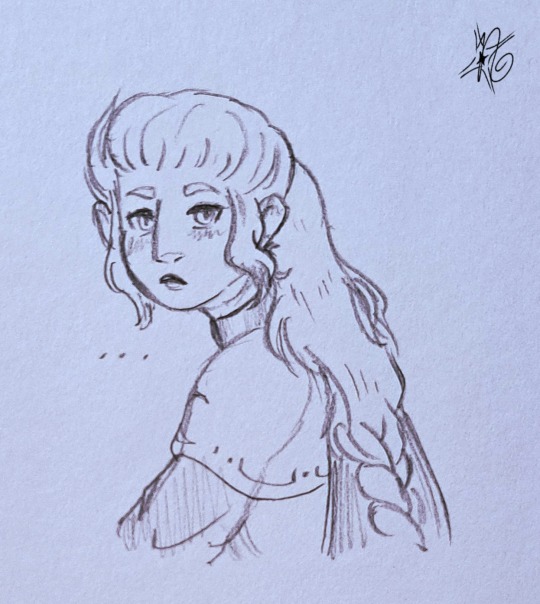
gerudo oc her name is riya :)
#loz the mage's lantern#loz untold myths#nocturnaldoodles#sketch#drawing#traditional drawing#fanart#legend of zelda#the legend of zelda#loz#tloz#loz fanart#zelda fanart#tloz fanart#gerudo#gerudo sage#zelda oc#loz oc#tloz oc#legend of zelda oc#oc#original character#tloz au#zelda au#loz au#sage of lightning#tml riya#doodle#tloz gerudo#loz gerudo
27 notes
·
View notes